Turnip cake (蘿蔔糕/萝卜糕, lo bak go in Cantonese) is a dish that you often find at dim sum. There are many regional variations of turnip cake. The one that’s most popular in dim sum restaurants is lo bak go, which is southern Chinese-style turnip cake. My mom’s recipe is this southern Chinese-style turnip cake. There’s also Taiwanese-style turnip cake, tsai tao kui (菜頭粿). You can check out my friend Irvin Lin’s recipe for tsai tao kui here.
Pan frying the turnip cake gives it a crispy exterior, while the inside stays soft. When you bite into a piece, you’ll taste umami flavors from ingredients like dried scallops, dried shrimp, Chinese sausage or Chinese cured pork. Mama Lin has made lo bak go for years, and I’m glad I can make it myself now. I may be biased, but I think Mama Lin’s turnip cake is the best!
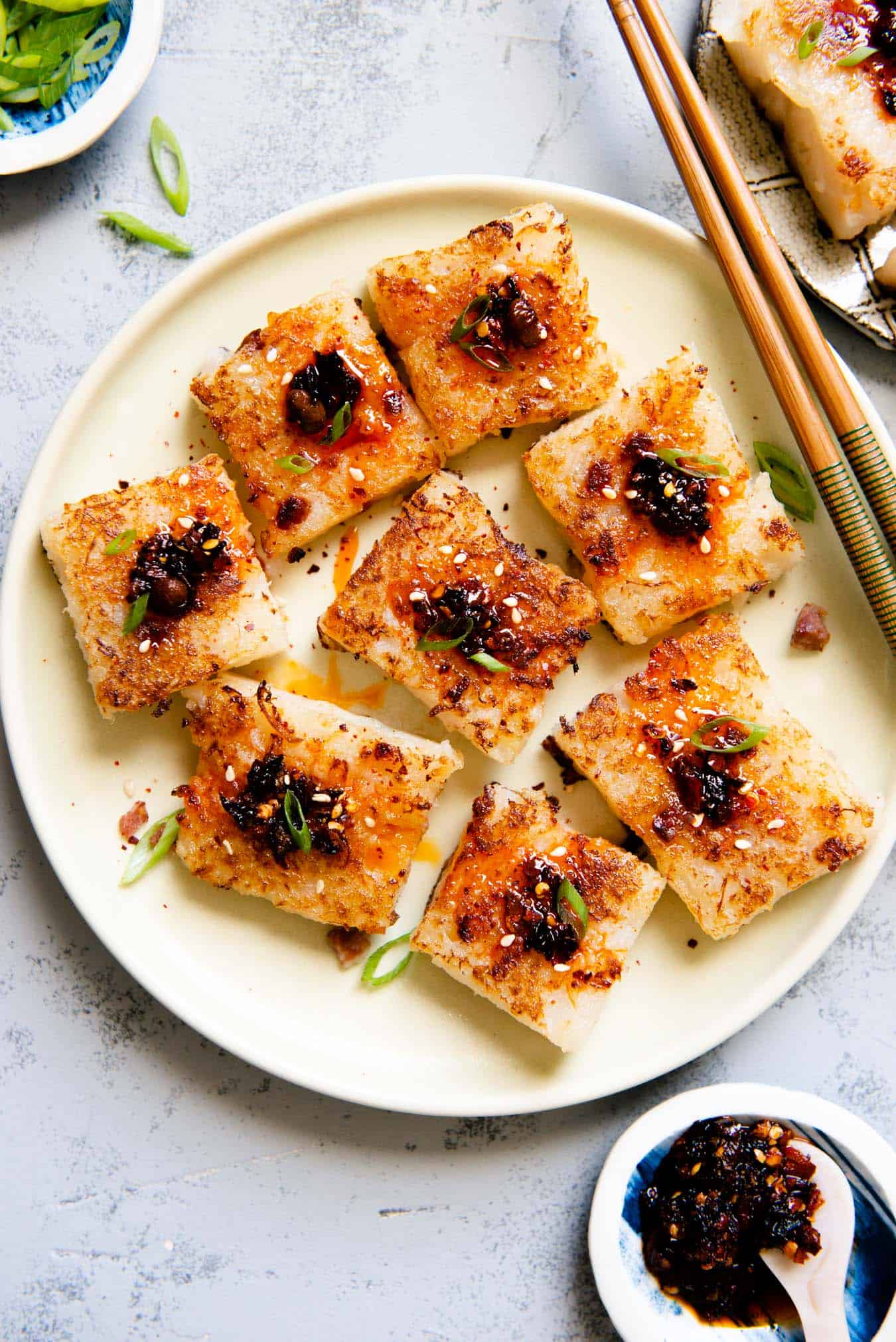
WHY IS LO BAK GO CALLED “TURNIP CAKE” IN ENGLISH?
The reason why lo bak go turned into “turnip cake” in English is convoluted and confusing.
Turnip cake is made of daikon (lo bak in Cantonese), a long white radish that’s commonly used in Asian cooking. Technically, this dish ought to be “radish cake.” However, lo bak go was translated as “turnip cake” by Chinese restaurants years ago, and that’s the name that has stuck. We will have to roll with it.
Another issue is how “糕” (go) is translated into English as “cake.” In Chinese, the word 糕 can refer to many different foods: sweet or savory batter that’s steamed into a solid cake, like lo bak go; sweet batter that is steamed into moist and airy cakes; or sweet batter that’s baked into Western-style cakes. I’ve always found “cake” to be an imprecise translation, but that’s the word you commonly see nowadays.
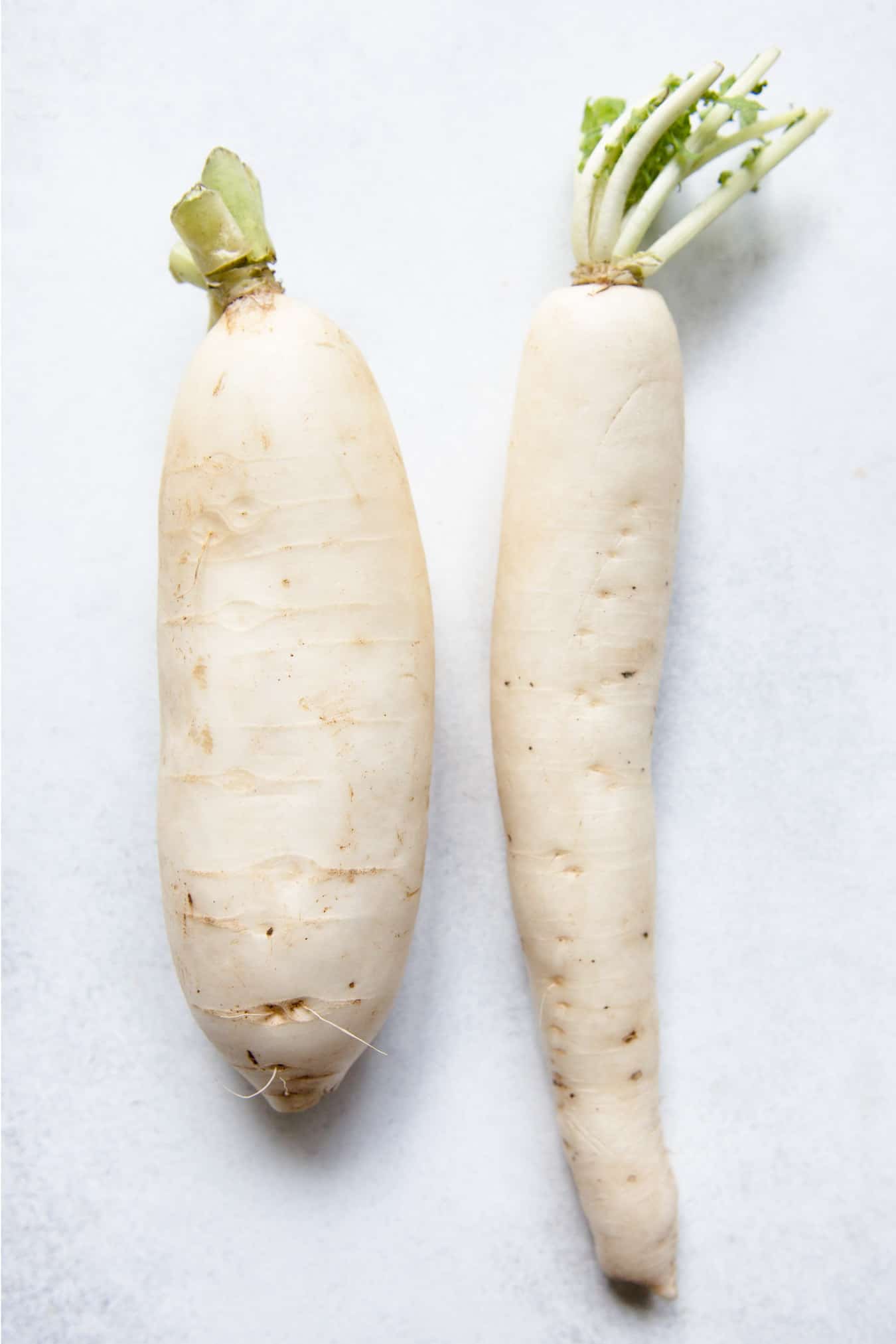
A NOTE ABOUT DAIKON
White radishes, like the ones you see above, are commonly used in Asian cuisine. This radish comes in many varieties. I commonly see them labeled as daikon in grocery stores and farmers markets. Daikon (大根) is the Japanese name for this radish and means “big root.”
Mama Lin prefers to cook with the radish on the left, which is thicker and more rounded. My mom calls it “Chinese radish.” According to my mother, the one on the right, which she calls “Japanese radish,” is more bitter. I can’t say that I notice that big of a difference between the two. Any daikon should work for this recipe.
HOW TO MAKE TURNIP CAKE/LO BAK GO
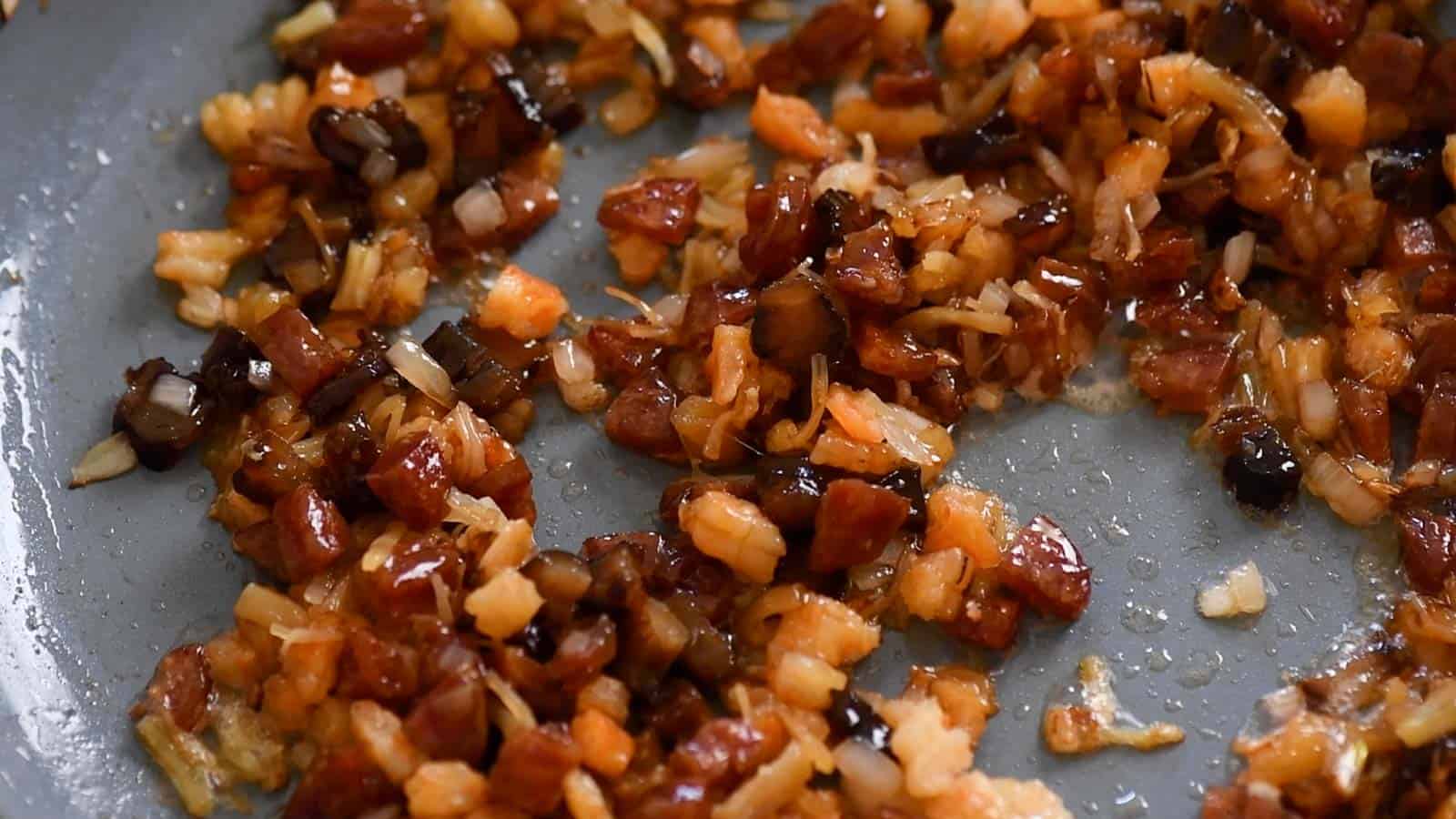
PREPARE FLAVORING BITS
Mama Lin likes using dried shrimp and dried scallops for her lo bak go. Soak them overnight to rehydrate. The scallops in particular need a few hours of soaking before they’re soft enough to be shredded. Mama Lin generally adds Chinese sausage (臘腸) and her homemade Chinese cured pork (臘肉) to flavor the lo bak go as well.
To bring out the flavor of these ingredients, my mom sautés them along with some shallots for a few minutes. She then seasons the flavoring bits with a bit of salt and oyster sauce.
PREPARE THE DAIKON
The first thing you want to do with the daikon is to trim the tops and peel the outer skin. As you peel the daikon, use a peeler or knife to strip away any dry and fibrous layers. This is particularly an issue if the daikon you purchased is not fresh.
Then, grate the daikon. If you are using a box grater, use the largest grate. Be sure to grate the daikon over a large bowl or a 9×13 pan, as you want to preserve all the daikon juices that run out. If you want to save time with food prep, you can grate the daikon using a food processor.
BOIL THE GRATED DAIKON
Before mixing the daikon into the batter, Mama Lin usually boils the daikon. She’ll fire up the wok and sauté a few smashed cloves of garlic to get the flavors going. Then, she combines the daikon, with 1 1/2 cups of water and cook the radish for 5 to 7 minutes.
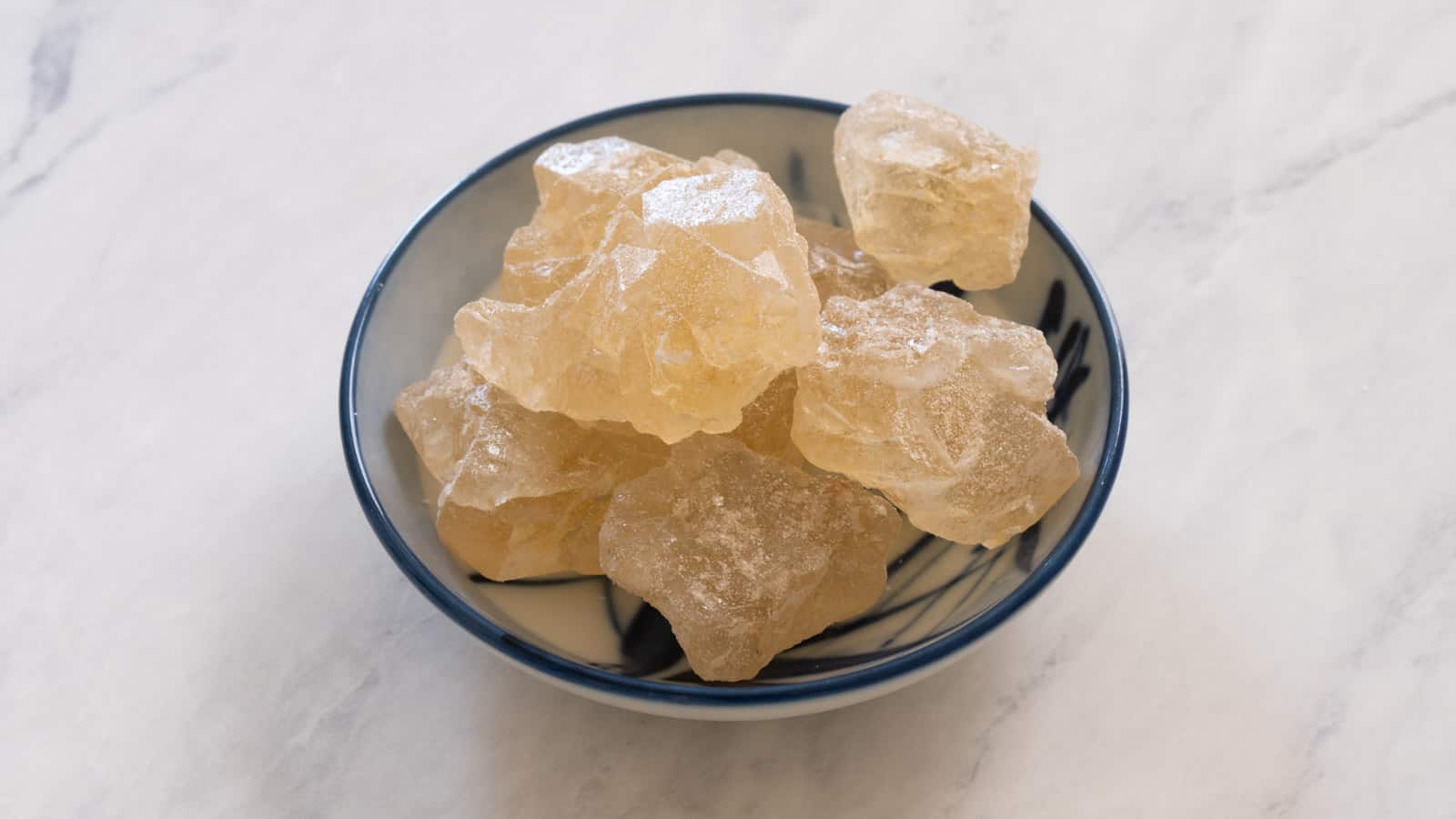
Daikon is slightly bitter, so she adds a few small pieces of yellow rock sugar to balance the flavors. (I also use rock sugar to neutralize the bitter flavor of the daikon in my vegan savory tang yuan recipe. You can find yellow rock sugar in Asian supermarkets or on Amazon. She prefers using rock sugar because she claims the sweetness is more pristine (清甜). You can substitute rock sugar with 1 tablespoon of granulated sugar.
MAKE THE BATTER
For the batter, Mama Lin uses a mixture of equal parts rice flour and cornstarch. The rice flour gives the cake structure while the cornstarch makes the cake softer. If you don’t have cornstarch, you can substitute it with another starch, such as potato starch or tapioca starch.
MIX DAIKON, FLAVORING BITS & BATTER
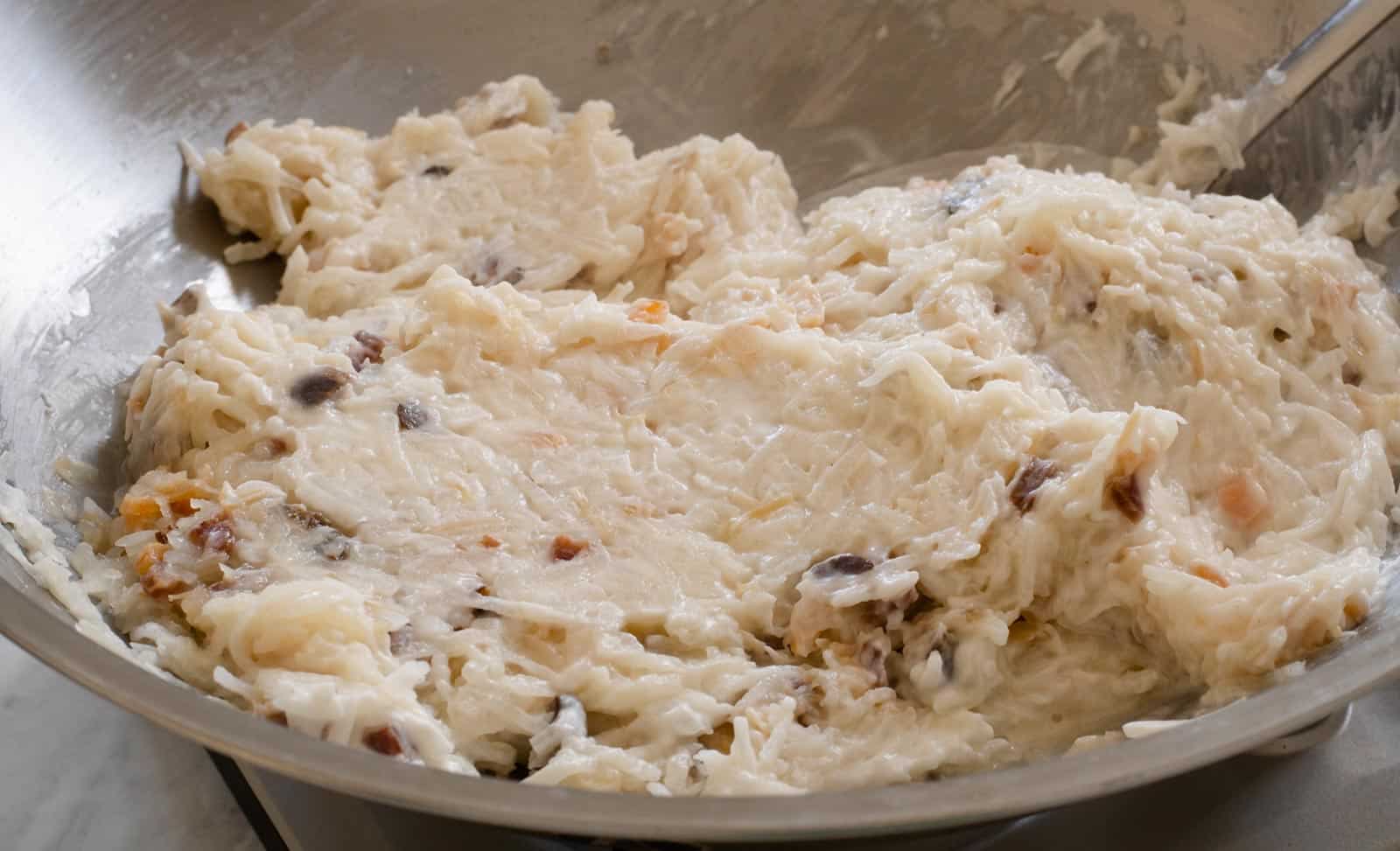
After you cook the daikon for a few minutes, mix in the flavoring bits. Make sure you reduce the heat to low. Then, carefully pour the batter into the wok. Stir everything together until the batter is no longer runny (see photo above). This shouldn’t take more than 1 or 2 minutes. If the batter is still very runny at this stage, the turnip cake won’t cook properly.
Pour all the contents of the turnip cake into a greased pan. Although I use a 9×2” circular cake pan, you can use any pan, like an 8×8 square pan. Whichever pan you use, you want to make sure it can fit into a wok or steamer.
STEAMING THE CAKE
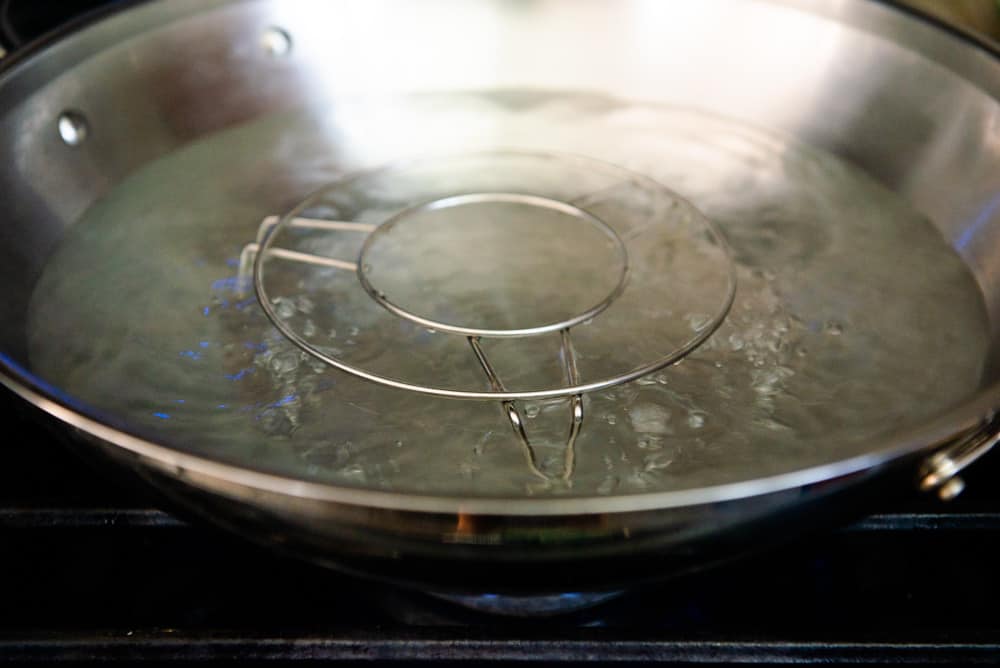
To set up the wok for steaming, place a steaming rack just over 2 inches high in the center of the wok. Fill the wok with enough water to reach just below the top of the steaming rack. Bring the water to boil.
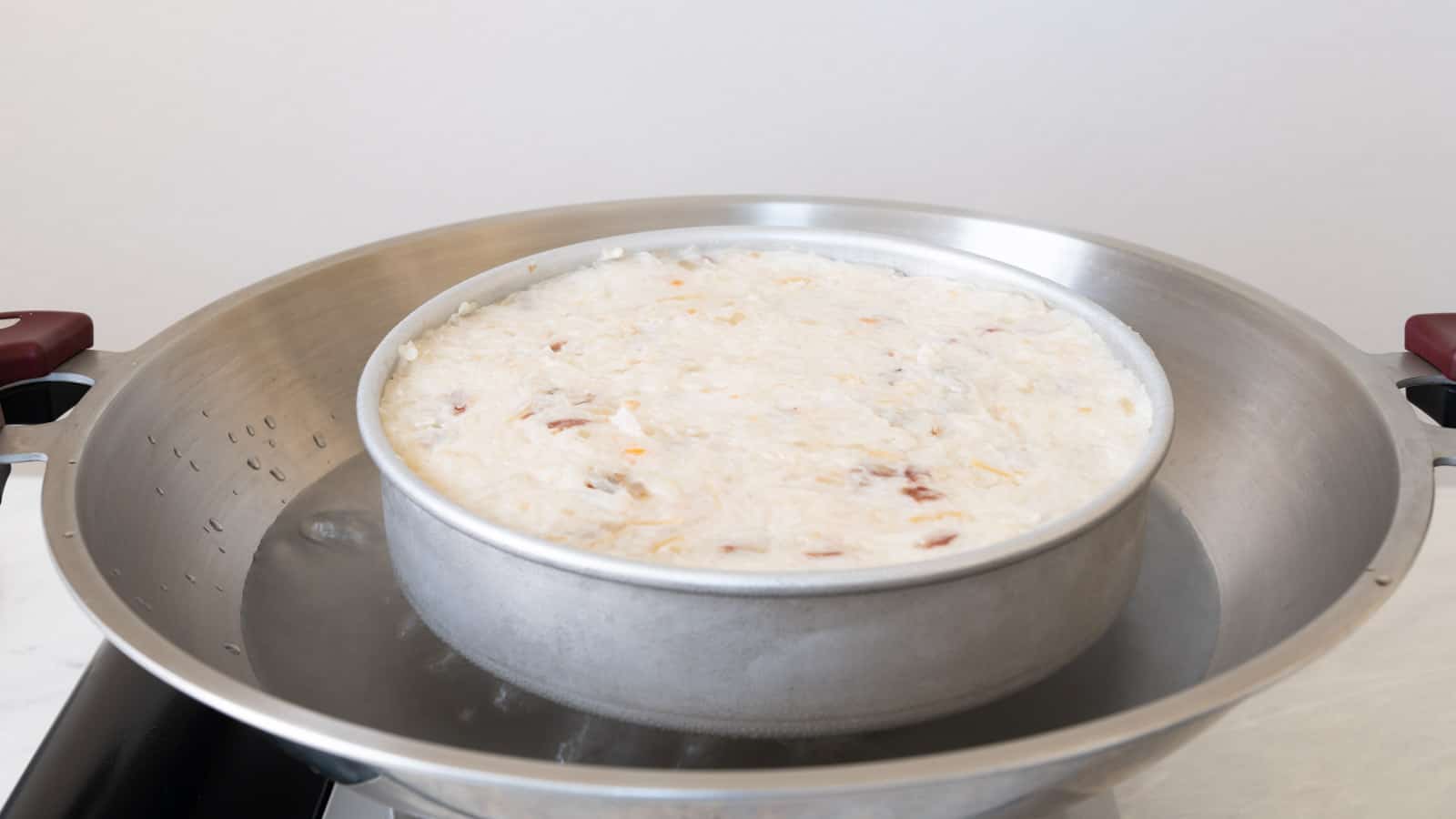
Carefully place the turnip cake above the rack. Cover and steam the cake for about 40 minutes.
I prefer using a large wok, like this 14-inch stainless steel one, for steaming.
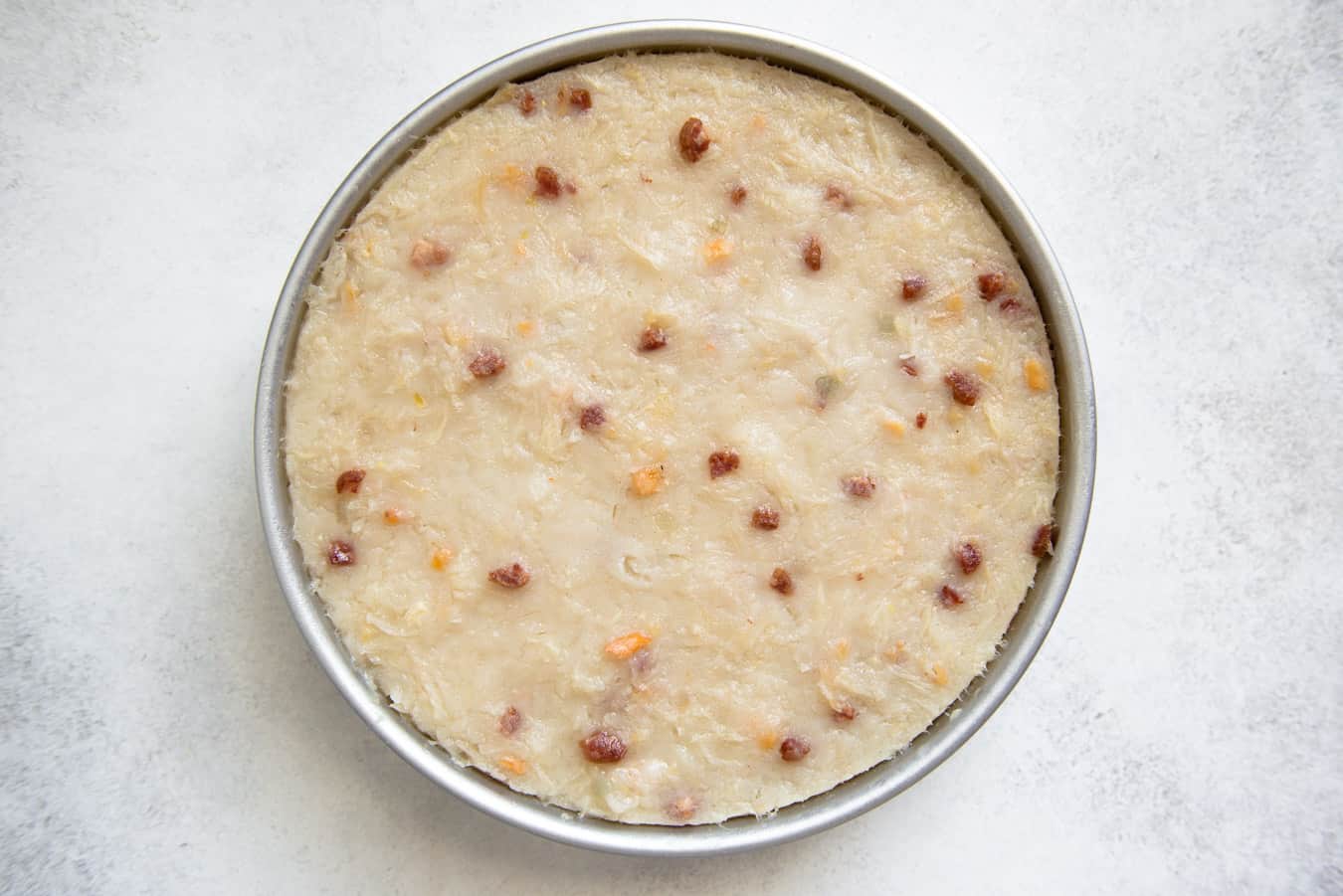
SERVING THE TURNIP CAKE
You want to let the cake cool completely before serving. Mama Lin likes eating the cake at room temperature because she likes the soft texture of the cake. I prefer it pan fried. Usually, I chill the turnip cake in the fridge overnight. That way, the cake becomes stiffer, which makes it easier for slicing and pan frying.
Turnip cake is excellent with chili oil crisp, such as Lao Gan Ma or Fly By Jing, or XO sauce.
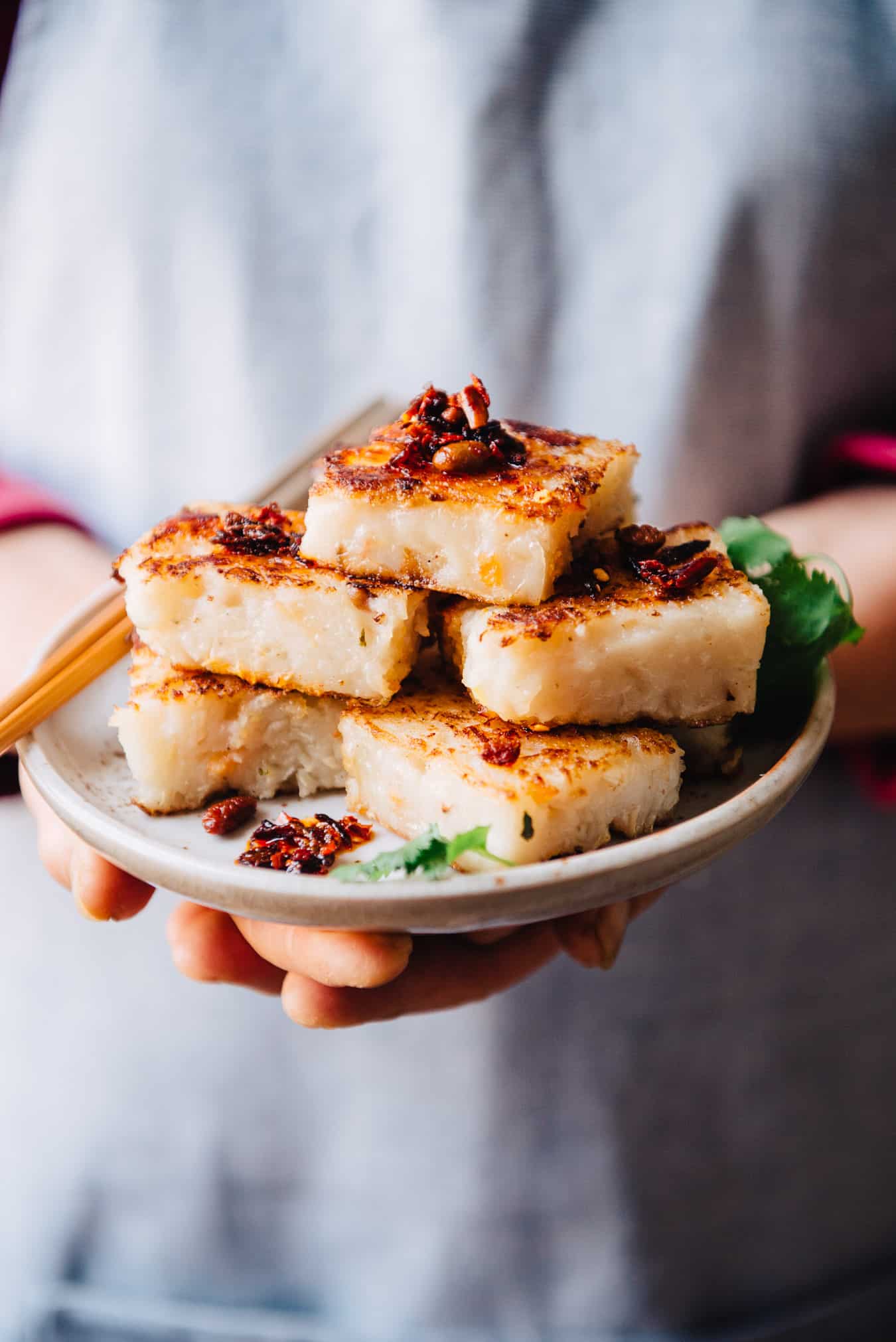
LOOKING FOR MORE DIM SUM?
- Cantonese Shumai (Siu Mai)
- Mushroom Cheung Fun
- Pork and Cabbage Potstickers
- Chicken Potstickers
- Curried Potato Fried Dumplings
Turnip Cake (Lo Bak Go, 萝卜糕, 蘿蔔糕)
Ingredients
Flavoring Bits
- 5 to 6 (15g) dried scallops, (see note 1)
- 1/4 cup (20g) dried shrimp
- 3 tablespoons (30g) chopped shallots
- 1/2 cup (65g) chopped Chinese sausage
- 1/4 cup (40g) chopped Chinese cured pork
- 1 1/2 tablespoon vegetable oil (any neutral oil works)
- 1 tablespoons oyster sauce
- 1/4 teaspoon (1g) Diamond Crystal kosher salt, use 1/8 teaspoon if using table salt
Daikon
- 2 1/2 pounds daikon (lo bak)
- 1 1/2 tablespoons vegetable or canola oil
- 4 to 5 cloves garlic, smashed
- 1 1/2 cups (355ml) water
- 2 small pieces (15g) rock sugar, can sub with 1 tablespoon granulated sugar
- 1 teaspoon (4g) Diamond Crystal kosher salt, use 1/2 teaspoon if using table salt
- 1/2 teaspoon ground white pepper
- 1/2 teaspoon chicken bouillon powder, (optional, see note 2)
- 1/4 teaspoon garlic powder
Batter
- 1 cup (115g) rice flour, measured with spoon-and-sweep method (see note 3)
- 1 scant cup (115g) cornstarch, measured with spoon-and-sweep method
- 1 cup (255ml) water
Equipment
- 9” round cake pan, (see note 4)
- oil for greasing pan
- 1 steaming rack (about 2-inches high)
- 14-inch wok with lid
Instructions
Prepare Flavoring Bits
- Soak the dried scallops and dried shrimp in water overnight. Drain the water. Shred the scallops with your hands. Roughly chop the dried shrimp.
- Heat 1 1/2 tablespoons of oil in a skillet (or sauté pan) over medium-high heat. Add the shallots and cook for about 2 minutes, stirring frequently. Next, add the dried shrimp, sausage, and cured pork and cook for a minute. Then, add the dried scallops and cook a minute more. Mix in 1/4 teaspoon kosher salt and oyster sauce. Turn off the heat and transfer everything to a bowl.
Prepare Daikon
- Peel the daikon and slice off the top. Grate the daikon into a 9×13 pan or a bowl. You are doing this to ensure that you save all the daikon juices that release as you are grating the turnips. Alternatively, grate the daikon using a food processor.
- Heat 1 1/2 tablespoons oil in a large wok (or deep sauté pan) over medium-high heat. Add the garlic to the wok and sauté for about a minute, until fragrant. Transfer the grated daikon (and any daikon juices) into the wok. Add 1 1/2 cups of water, the rock sugar, salt, white pepper, chicken powder, and garlic powder to the wok. Make sure to place the rock sugar into the water to ensure that it dissolves properly. Cover the wok with a lid and cook the daikon on high heat for about 5 to 7 minutes.
Make Batter
- While the daikon is cooking, make the batter. Whisk the rice flour and cornstarch in a mixing bowl. Add 1 cup of water and stir. The batter might be stiff at the beginning, but keep stirring until the batter is smooth.
Mix Daikon, Flavoring Bits & Batter
- Uncover the wok and reduce the heat to low. Dig out the pieces of garlic from the daikon. You don’t want large chunks of garlic inside the cake. Add the flavoring bits and stir to combine. Then, add the batter to the daikon and stir until batter is no longer runny. The batter should thicken in a minute or two. Turn off the heat.
- Lightly grease the cake pan with oil. Transfer all the ingredients from the wok to the cake pan. Use a flexible spatula to smooth out the top of the turnip cake.
Steam Cake
- Wash the wok. Place a steaming rack in the center of the wok and fill it with enough water so that the water level is just below the top of the steaming rack. Bring the water to boil.
- Carefully place the turnip cake on top of the steaming rack. Cover the wok and cook on medium-high for 40 minutes. Make sure to replenish the water after 25 minutes because it will evaporate.
- Turn off the heat and uncover the wok. Using oven mitts, transfer the cake to a cooling rack. You may notice some water on top of the steamed cake because of condensation that builds up under the wok lid. That’s okay. Let the cake cool for 10 minutes. If there's still a thin layer of water on top, carefully tip the cake pan to drain the water.
Serving Turnip Cake/Lo Bak Go
- Let the cake cool for 30 minutes to 1 hour before slicing and serving. If you want to pan fry the cake, let it cool completely, preferably overnight. The cake needs to set before pan frying. Otherwise, the cake will be soft and mushy.
- To pan fry, slice the cake into small squares or rectangles. Heat 2 tablespoons of oil in a large skillet over medium-high heat. Add the turnip cake pieces and pan fry each side for about 3 to 4 minutes, until golden brown. Serve the turnip cake with Lao Gan Ma chili crisp or soy sauce.
Video
Notes
- These scallops are about 1/2 to 3/4 inch in diameter (dried).
- My mom uses chicken powder often to enhance the umami flavor of her dishes. Feel free to leave it out. You can substitute the chicken powder with onion powder to give the dish more flavor.
- I usually use Thai rice flour that comes in the bag with the red label. This is NOT glutinous rice flour or mochiko. Sweet rice or glutinous rice flours won’t work with this recipe because they will make the cake chewy. I typically weigh my flours. See here for more info about the spoon-and-sweep method of measuring flour.
- You can use an 8×8-inch square pan or any pan that fits inside a wok. If you use a loaf pan, you’ll likely need to add another 5 to 10 minutes to the cooking time because of the depth of the pan.
- Lo Bak Go Waffles: You can fry up chilled lo bak go in a waffle iron! Cut the cake into 1/2-inch thick squares. Then fry them in a greased waffle iron on medium heat for about 5 to 8 minutes, until they turn golden brown. Some waffle irons heat faster than others, so start checking the cakes at 5 minutes. I usually need to cook the cakes for 7 to 8 minutes.


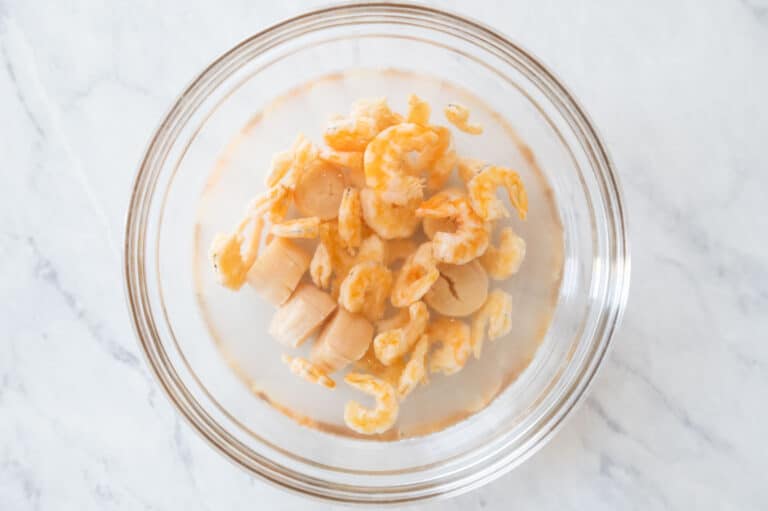

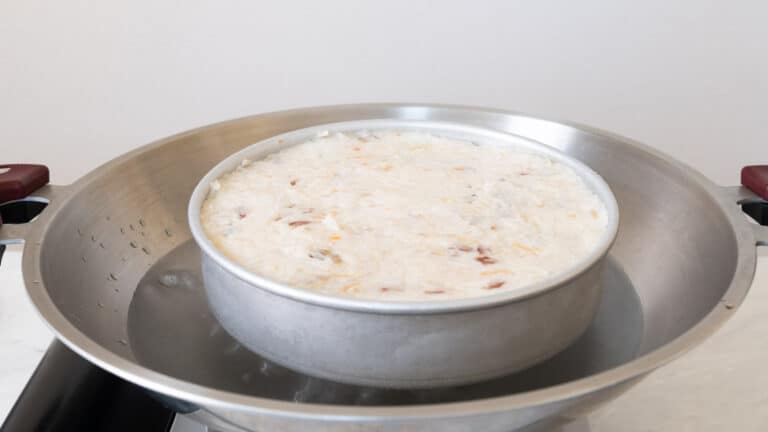

Jen Houng says
Hi Lisa! I love turnip cakes and decided to try this out! The step by step made this simple to make! I figured it’s about 2.5 cups of water per 8oz of flour. The flavor is spot on, and my entire family loved it. I used a loaf pan instead of a round pan. The center of the cake is a bit dense compared to the outer edge, what did I do wrong? Thank you!!!
Lisa Lin says
Hi, Jen! Is your loaf pan something like 9×4 inches? I wonder if it’s because the surface area of those loaf pans are smaller, the center will cook very evenly. Thanks for trying out the recipe!
joes says
Hi Lisa, I intend to try this recipe but since I am alone I am bound to have leftovers. Can I store the unfried leftovers in the freezer?
Lisa Lin says
Absolutely! Try to store them in an airtight container because the cake can get freezer burn over time.
Grace says
Firstly, thank you for making my homemade Chinese food dreams come true, Lisa! Growing up my mom taught me how to cook, but it was always “oh just add a little bit of this and that and cook it until it looks like THIS” she never gave me any recipes.
I’m not the greatest cook, but I’m really good at following directions. This recipe was super easy to follow, and my lo bak go turned out amazing. My only complaint is that it came out a touch too soft, maybe my turnips were extra juicy, but if I make it again, I might reduce the water by a little. I threw the turnips into a food processor, which preserved every last bit of juice- so perhaps that’s why. I also only soaked my dried shrimps for a few hours because I wanted to make it same day, but it turned out okay! The flavor was SPOT ON, just what I imagined it should taste from years of eating dim sum (I added the chicken powder).
Lisa Lin says
Hi, Grace! Your observation about the juiciness of the turnips is spot on. Under normal circumstances, if my mom notices that the turnips she’s using is particularly juice, she won’t add as much water to the batter. But if they are looking dry (i.e., not that many juices run out when grated), she’ll add less water. I will make a note of this in my recipe!
Wendy says
Thank you for this recipe! I’ve been wanting to make Chinese radish cake on my own for some time now, esp. since I’m living in Switzerland away from home. This helped me bring back memories of eating this during my childhood years 🙂
Some things I did differently
* I didn’t have a wok lid so steaming in it wasn’t an option. I ended up using the built-in steamer function of the oven, set it to 200 C for 30 min. I also put a tray of water next to it to create more steam
* I used three small radishes of the “Japanese type” shown in the photo and eye-balled weight
* Instead of corn starch, I used potato starch. Still works!
* I didn’t have chicken powder so I used bits of a chicken broth cube
* I put in chinese sausage and shallots, and skipped the dried shrimps.
Valerie says
Hello, I adore your website and I make the sesame candy on rotations as my family adores them! I wanted to try to make de turnip cake today and I understand that the chicken powder is optional and that I can use onion powder as a substitute but I was wondering if instead of the water I can use chicken broth maybe? Thank you!
Lisa Lin says
Yes to both substitutes! Let me know how it goes!
Lisa Lin says
And thank you so much for making the sesame candy!
Mollie says
I have been dreaming about the “carrot cake” made with these turnip cakes since I visited Singapore last year! Do you have a recipe for how to make them once you have the turnip cakes make?
Lisa Lin says
Hi, Mollie! Sorry, what kind of recipe are you looking for exactly?
Jole says
Hi Mollie, jumping in here! For the Singapore style carrot cake, you can slice up the cake into cubes and stir fry with eggs and sweet black sauce! I would also skip the fillings in this dish for the Singapore style carrot cake 🙂
Sarah A. says
Hi! Two questions:
1) Approx how much is 2.5lbs of daikon? I don’t have a scale so I just used 1 daikon radish since it felt to me about 2.5lbs.
2) I followed the recipe, but my Turnip Cake ended up too gooey and wouldn’t hold its shape. What do you think went wrong? I thought of what possibly went wrong, but I wasn’t sure… Was it because I used 1 radish? Was it because the radish I used had a lot of juice already, so I didn’t need to add the full 1 cup of water? Or maybe I needed to turn the heat back on when I added the flour batter to the daikon. (The recipe’s step #6 is a little unclear. It said the “Uncover the wok and turn off the heat.” then later said to “Turn off heat” again. But didn’t say when to turn on the heat in between. Do you turn the heat back on when you pout the flour batter into the daikon? If so, then how long until you turn off heat?)
Lisa Lin says
Hi, Sarah! In terms of size of daikon, it really depends on which variety you use. If you’re using the long and thin ones, then you need a pretty long daikon. If you’re using the very round daikon, a medium-sized one will do. If the radish had a lot of juice when you grated it, then yes, you probably didn’t need the entire cup of water. It is difficult to predict how juicy the turnips will be until you grate them, unfortunately.
And thank you for catching that error. The last “turn off the heat” should not be there.
KK says
I just tried making this last night and ran into a couple issues:
1) The cake never really fully set. I steamed it for 30 minutes and then an addition 20. I chilled it overnight but as soon as it hit the pan it started spreading a little and turned into mush instead of holding its cut shape. I’m not really sure what went wrong here!
2) There is a slight bitter taste. Could it be that I didn’t cook the grated radish long enough during that step?
Other than the odd bitter taste, the flavors were great. I just need to figure out what went wrong before my second attempt! Thanks!
Lisa Lin says
Hi, KK! I’m sorry this happened to you! I wonder if the turnips during this time of the year are more juicy and require less liquid to cook. That could explain why the cake never fully set. Unfortunately, it’s tough to tell how juicy they are. By chance, did you weigh the turnip before you grated it? As for the bitter taste, you can try adding a little more sugar when you are cooking the turnips (before mixing the turnips with the batter).
Myrna says
Love radish cake and would like to try this recipe. If you double the recipe, do you double the 1 cup
Of water in step #5? I see the ingredients double in quantity but not in the procedure section.
Thank you,
Myrna
Lisa Lin says
Ah, I probably won’t double the amount of water, in case that’s too much liquid. Try 1.75x the amount of water.
Robin says
Hi Lisa!
I love this recipe! I made a bit too much, do you think it will freeze well? Thank you!!
Michelle says
Do you have a particular brand of rice flour that you would recommend?
Lisa Lin says
Hi Michelle, thanks for reminding me that I need to share a photo of the rice flour. I usually use Thai style rice flour for this, which comes in a red bag. The 3 elephants brand or SunLee brand works for this recipe.
Anil Kulkarni says
I used this recipe for the first time today. – High praise all around. Thank you so much.
I substituted 8oz of tapioca flour in place of the cornstarch
Melissa Hoff says
Cake is an appropriate translation. Cake can be used to describe sweet and savory items. It also resembles a flattish compact mass of something like a cake of soap. So I’d say that the translation radish cake is spot on.
Definition of cake
/kāk/
an item of savory food formed into a flat, round shape, and typically baked or fried.
“crab cakes”
a flattish, compact mass of something, especially soap.
“a cake of soap”
Laraine says
I have never tried or even heard of radish cake. But daikon is a vegetable I regularly use for soups, stews, stir fries, salads, bibimbap, stock etc. I always still seem to have a fridge full of it though. So was pleased to find this recipe.
I’m not sure how but this recipe yielded 3 cakes (of the recommended size). I used my freshest radishes which did give a lot of juice. After adding the batter I felt the mixture was far too watery so I drained it off, made more batter and added that to the mix. As I had 3 tins and being unsure of what the right consistency should be I decided to vary the consistency of each one. They all set in the fridge. Even the one that I felt was too watery.
It oozed a little on frying but by breaking it up into small pieces, frying until crisp, adding some garlic and seasoning sauce I was able to make a decent dish out of it. I haven’t yet tried out the less watery ones.
I will definitely be having another bash at this recipe. In fact this is a perfect recipe for using up the daikon that isn’t at it’s freshest. Next time I plan to squeeze the juice the out of the daikon and reserve it, boil the daikon until the water has evaporated and use the daikon juice mixed with chicken powder or chicken stock powder to make the batter. I didn’t use chicken powder this time ( I didn’t have any) and feel I should have done.
So, even though this recipe didn’t work perfectly for me first time, I was able to rescue it and make something of it. The cakes can be sliced and frozen too, possibly helping to firm up the soft ones, so they won’t be going to waste.
Thank you for this recipe.
Dan says
Thank you for this recipe. It was my first turnip cake and it came out great. Wonderful flavor and texture, especially when pan seared.
Lisa Lin says
Awesome! Thanks, Dan!
Mable Tew says
I followed this recipe by just adding some diced dried mushroom. The result is awesome! Thank you very much for sharing the recipe Lisa! ❤️
Lisa Lin says
Thanks, Mable!
Claire says
Do the scallops have to b dried? I can’t find them at any Asian market.
Lisa Lin says
Hi Claire, they do need to be dried. If you can’t find them, you can leave them out and add a little bit more dried shrimp. It will still taste good!
Lily says
I love 蘿蔔糕, I sometimes have them for my breakfast! Thanks for sharing this recipe
Parrish says
Beautiful. I followed the recipe as you wrote and it came out perfectly! Thank you so much. I can now make one of my favorite dim sum items at home.
Lisa Lin says
Thank you so much!
Gail says
is the rice flour sweet or regular?
Lisa Lin says
Regular. I generally make it very clear if I’m using sweet rice flour. Tap on the link in the ingredients to see exactly what recipe I’m using.
Kristen says
If I added small cubes of taro to this recipe. Do you think they could cook through properly?
Lisa Lin says
I think so, if you dice them into pretty small cubes.
Vixenvena says
This did not taste like a cake. It is very savory. I added pineapple and coconut to it. It still didn’t taste like a cake. I would recommend eating this because it’s so unusual but definitely add some pineapple.
Jess says
This isn’t supposed to be a cake. It is an Asian savoury steamed turnip “cake” that we often eat with pan fried and with soy sauce or chilli sauce. Your addition of pineapple and coconut makes no sense and is unnecessary to the original recipe.
Jen says
What an excellent recipe. Reminds me of my childhood, but, even better. Thank you! Can’t wait to try more of your recipes.
Chance says
Do you have this recipe in Chinese? My aunt loves to cook and is very interested in making this but she can’t ready ENGLISH on Chinese. Thank uou.
Noriko Hayashi says
Hi Lisa I’m Noriko. I made turnip cake by myself last weekend. The one I cooked was sticky a little. I used rice powder 150g and I grated daikon. How should I do to make better texture. I love Turnip Cake since I had it for the first time at the restaurant in HongKong 1996.
Lisa Lin says
Hi Noriko, I am just seeing this! Sorry, did you use my recipe, or is this someone else’s recipe?
Threes says
A tip from my mom, another turnip cake expert: save a bit of the seafood mixture and sprinkle it on top of the cake before steaming to make the final product look prettier.
Eden says
This is one of my favorite dim sum dish. I’m struggling to find good dim sum restaurant here in Lisbon and making them (for the first time and successfully) really made my day.
Thank you so much!
Slope 3 says
One of my favourite recipes. Thank you for sharing. I love the way it is explained so clearly.